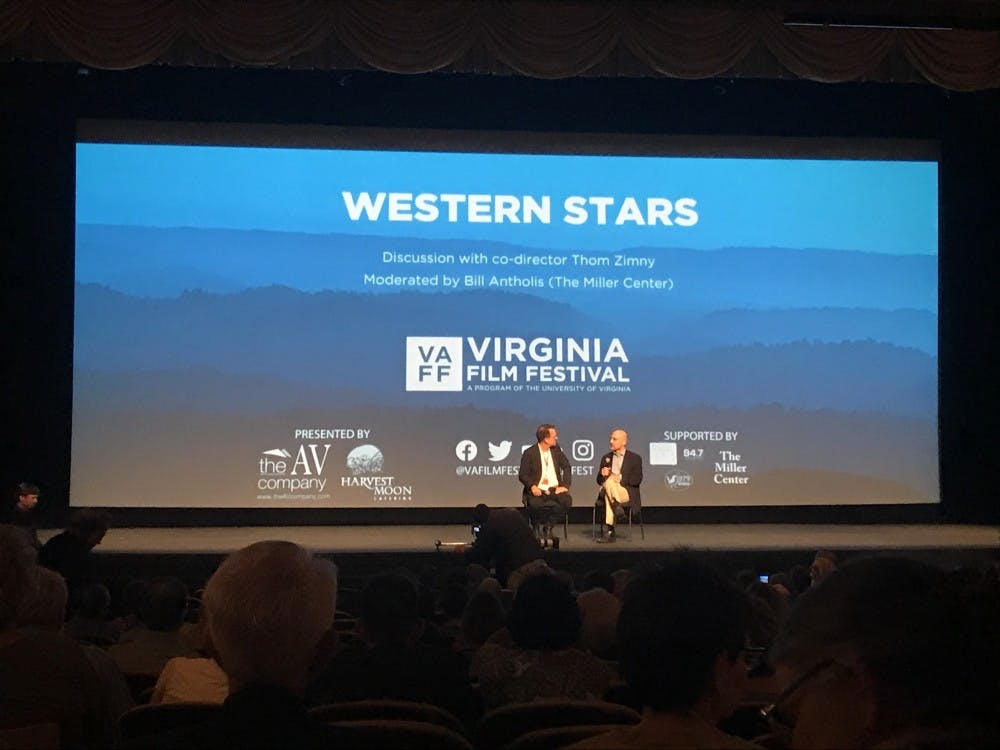“Western Stars” is the newest Bruce Springsteen concert documentary, directed by Thom Zimny and Bruce Springsteen. Jody Kielbasa, Director of the Virginia Film Festival and U.Va. Vice Provost for the Arts, introduced it to a crowd of mainly older Charlottesville residents Thursday night at The Paramount. He touted the VAFF as being one of the very few film festivals in the United States that was given the rights to screen Springsteen’s latest — which was underscored when co-director Thom Zimny was promised to be answering questions after the screening.
William Antholis, the Miller Center’s director and CEO, who sponsored the screening, prefaced the film with an explanation of his interest in Springsteen, and gave a brief summary of what the film meant to him personally. Antholis talked about how the film investigates what truly motivates Americans, searches for the new American Dream and displays the dark underside of freedom.
The film itself is about an hour and a half long, consisting of Springsteen and his wife, musician Patti Scialfa, playing the records off his newest album, “Western Stars.” It was interlaced with home videos of Springsteen’s childhood, cinematic shots of the Western plains often featuring wild horses and narration by Springsteen explaining his songs and their meaning before cutting back to the concert.
The concert took place on Springsteen’s expansive California desert property, in a barn originally built in the 1800s. The wooden structure, roughed by centuries of sand, is vaulted high with cathedral ceilings, lined with twinkling lights and surrounds a 30-piece orchestra that supported Springsteen and Scialfa. The barn, Springsteen alludes to in his narration, is an instrument of the concert itself, guiding his low drawl and the string sections’ melodies up towards the high sky and back down to the few members of the crowd.
In this setting, Springsteen breaks the fourth wall to explain that “as you hoped, the music started to take on a life of its own.” Balancing Springsteen’s cowboy-like ruggedness with the large ensemble speaks to the message of Springsteen’s album — the conflict between the yearning for rugged individualism and freedom as well as the need for community and collective effervescence.
The album explores the destruction of the old American dream — the one of open roads, labor in the unforgiving sun, independent freedom and solitude — the dream that Springsteen explains he frequently sacrificed genuine love and community for in his turbulent and destructive youth. The movie is raw, the feeling of a sore throat after recounting your past regrets and self-desecration. The beginning paints Springsteen as a cowboy, a man eloquently explaining all the reasons why he should be alone in his old age. This is emphasized by the title song, “Western Stars,” which is a look into the life of a worn out old country Western actor who survives on the pay from Viagra commercials and the acceptance that his life will never again be what it was in his hayday.
But slowly, over the course of the film where all 13 songs are played, Springsteen introduces the idea that for all of the ease of a solitary life, the most courageous act a person can commit is to give yourself to someone that you unselfishly love. Chronicling his love story with Scialfa, beginning with their affair during Springsteen’s first marriage, he speaks about the freedom love can bring into a life previously filled with pain and loneliness. Filled with endearing videos of the couple in their youth, and accompanied by the duets between the couple during the concert, it is clear just how far Springsteen has come from his destructive past. The new American Dream is the reconciliation of individual freedom with the people who love you and who you love in return.
The songs “There Goes My Miracle” and “Hello Sunshine” expose the soft, adoring part of The Boss, where the film comes to a close with a shot of Springsteen’s hand, adorned with a gold ring and turquoise cuff, resting on the steering wheel of his old Camero. His hand is slowly joined by Scialfa’s, fingers intertwining as the screen goes black.
The movie is everything Springsteen is — eloquent, raw, concise and beautiful. Long-time Springsteen fans will feel more connected to their idol, and prospective fans will be immersed in Springsteen’s ability to evoke the ubiquitous but indescribable experience of being human in changing times.
Following the screening, Zimny, who has now directed multiple musical documentaries — including ones about Elvis Presley and Johnny Cash — joined Antholis on stage to talk about the making of the movie. Zimny has worked with Springsteen for over 20 years, but started off as a fan. He grew up minutes away from Springsteen’s hometown, where he says that Springsteen’s music was in his DNA, an integral part of growing up. Zimny began working with Springsteen as an editor for the 2001 HBO documentary “Live in New York City.” From then, Springsteen gradually gave Zimny more responsibilities in the production of concert films, until Zimny directed his 2018 special “Springsteen on Broadway.”
This close partnership and relationship is clear from the film. Springsteen is candid and comfortable with Zimny and both of them were, as Zimny said following the screening, “open to what the film was telling us.” They started the production by filming the concert and slowly came to cut together audio of Springsteen’s scripted narration over scenic desert clips and home movies from Springsteen’s childhood. Zimny’s presence at the festival showed the crowd the craftsmanship and the long process of creating this intricate and moving film.







